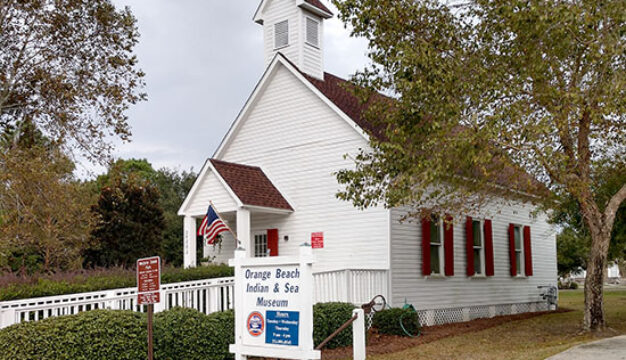Forks of Cypress
 Forks of Cypress Mansion
Built for Irish immigrant James Jackson and completed in 1830, the Forks of Cypress mansion was situated on a plantation that encompassed 3,000 acres. Jackson purchased the land for his home from Cherokee chief Doublehead and would later gain renown for importing and breeding race horses. The mansion was one of the earliest Greek Revival homes built in Alabama. It was designed by noted architect William Nichols who also designed the state capitol building in Tuscaloosa, Tuscaloosa County, and the University of Alabama's original campus. It was located just west of present-day Florence, Lauderdale County, between the forks of Big and Little Cypress Creeks. The building was a tourist attraction as well as a museum for a number of years but burned in 1966, leaving only 24 brick columns.
Forks of Cypress Mansion
Built for Irish immigrant James Jackson and completed in 1830, the Forks of Cypress mansion was situated on a plantation that encompassed 3,000 acres. Jackson purchased the land for his home from Cherokee chief Doublehead and would later gain renown for importing and breeding race horses. The mansion was one of the earliest Greek Revival homes built in Alabama. It was designed by noted architect William Nichols who also designed the state capitol building in Tuscaloosa, Tuscaloosa County, and the University of Alabama's original campus. It was located just west of present-day Florence, Lauderdale County, between the forks of Big and Little Cypress Creeks. The building was a tourist attraction as well as a museum for a number of years but burned in 1966, leaving only 24 brick columns.
The exterior of the plantation house featured wooden siding and a temple-like veranda supported by 24 massive Ionic columns that encircled the entire home. These columns were made on site from a mixture of materials, including brick, plaster, gravel, sand, molasses, and horsehair. The two-story home had four large bedrooms upstairs separated by a central hallway.
 Peytona vs. Fashion Horse Race
The downstairs also included a hallway that divided the house in half. The structure had four chimneys, a parlor with a hand-carved mantle, and a dining room mantle that included hand-carved rosettes. Another notable feature was a fan-shaped transom over the double doors in the front. Food was stored in a cellar under the house, and the kitchen was located in a separate building near the house.
Peytona vs. Fashion Horse Race
The downstairs also included a hallway that divided the house in half. The structure had four chimneys, a parlor with a hand-carved mantle, and a dining room mantle that included hand-carved rosettes. Another notable feature was a fan-shaped transom over the double doors in the front. Food was stored in a cellar under the house, and the kitchen was located in a separate building near the house.
A long driveway lined with trees led visitors from the road to the house. The grounds included stables and a regulation racetrack for Jackson's horses. A blacksmith shop and carpenter's shop were also part of the plantation's structures, with plows and wagons being made on site. The work was performed by enslaved people who also cultivated cotton and corn and produced molasses and butter. The garden, located behind the house, included many varieties of berries and vegetables, including artichokes and asparagus.
Forks of Cypress after Jackson's Death
Jackson, who also owned a plantation in Mississippi, died on August 17, 1840, and was buried in the Jackson Cemetery near Forks of Cypress. Jackson's widow, Sally, continued to live on the plantation with Jackson's nephew Thomas Kirkman Jr. and his wife, Elizabeth McCulloch Kirkman (Jackson's stepdaughter), until her death in 1879.
 Forks of Cypress Interior
In the 1860 Census, Sally was listed as the owner of 1,900 acres, 80 slaves, and 14 slave houses. The home stayed in the Jackson family for several years following her death, and Thomas Kirkman would continue to breed and race horses, but it is not clear when the plantation passed out of the hands of Jackson's descendants. Hugh and Sadie Scott purchased the property in 1910, and A.R. Scott took up ownership in 1912. In 1935, the property was briefly owned by J. W. Scott. From 1936 to 1989, the Jessie Dowdy family owned the property. It had been surveyed in the 1930s by the federal Historical American Building Survey, a New Deal initiative. When Dowdy died in the 1940s, the plantation, totaling approximately 1,000 acres, was split between three people. Rufus Dowdy was given about 330 acres that encompassed the main house and a cabin, and two other family members inherited the rest of the property.
Forks of Cypress Interior
In the 1860 Census, Sally was listed as the owner of 1,900 acres, 80 slaves, and 14 slave houses. The home stayed in the Jackson family for several years following her death, and Thomas Kirkman would continue to breed and race horses, but it is not clear when the plantation passed out of the hands of Jackson's descendants. Hugh and Sadie Scott purchased the property in 1910, and A.R. Scott took up ownership in 1912. In 1935, the property was briefly owned by J. W. Scott. From 1936 to 1989, the Jessie Dowdy family owned the property. It had been surveyed in the 1930s by the federal Historical American Building Survey, a New Deal initiative. When Dowdy died in the 1940s, the plantation, totaling approximately 1,000 acres, was split between three people. Rufus Dowdy was given about 330 acres that encompassed the main house and a cabin, and two other family members inherited the rest of the property.
The plantation house burned on June 6, 1966, when a severe thunderstorm produced cloud-to-ground lightning that struck the mansion, setting it on fire. All that was left standing were the 24 columns that had surrounded the foundation and supported the veranda roof. The home was owned by Rufus B. Dowdy at the time of the fire and had served as a museum that housed antiques worth perhaps a million dollars. Imported china, silver and glassware, pioneer artifacts, and other museum pieces were lost in the fire. The Forks of Cypress had been the top tourist attraction in Florence. The Mitchell family purchased the main house property in 1989. They then sold it to the Ricky Irons and Gilbert Nelson families.
 Forks of Cypress Columns
In 1993, Heritage Preservation Inc. sponsored an archaeological survey completed by Linda Stine, a professor at Samford University, and several volunteers from the Florence area. The main focus of the survey was to study a log cabin on the property that had been partially burned by vandals in 1992. The building had been constructed in the saddlebag architectural style, which is distinguished by two rooms separated by a wall with a central chimney between them. The survey also documented two intact twentieth-century barns, a cistern, a well, an original smokehouse, a frame tenant house from about 1930, an African American cemetery, and the Jackson family cemetery, as well as the subterranean remains of workshops, previous barns, slave quarters, and an icehouse. In addition, archaeologists also found evidence of prehistoric Native American occupation from the Late Archaic period near the plantation on the south side of Little Cypress Creek.
Forks of Cypress Columns
In 1993, Heritage Preservation Inc. sponsored an archaeological survey completed by Linda Stine, a professor at Samford University, and several volunteers from the Florence area. The main focus of the survey was to study a log cabin on the property that had been partially burned by vandals in 1992. The building had been constructed in the saddlebag architectural style, which is distinguished by two rooms separated by a wall with a central chimney between them. The survey also documented two intact twentieth-century barns, a cistern, a well, an original smokehouse, a frame tenant house from about 1930, an African American cemetery, and the Jackson family cemetery, as well as the subterranean remains of workshops, previous barns, slave quarters, and an icehouse. In addition, archaeologists also found evidence of prehistoric Native American occupation from the Late Archaic period near the plantation on the south side of Little Cypress Creek.
 James Jackson Portrait
The site of the Forks of Cypress ruins is now owned by the Alabama Historical Commission. The access road is privately owned, restricting public access, but the ruins are visible from the surrounding roads. The site was listed on Alabama Register of Landmarks and Heritage in 1992 and the National Register of Historic Places in 1997. Some of the pieces from the mansion are displayed at the Pope's Tavern Museum in Florence.
James Jackson Portrait
The site of the Forks of Cypress ruins is now owned by the Alabama Historical Commission. The access road is privately owned, restricting public access, but the ruins are visible from the surrounding roads. The site was listed on Alabama Register of Landmarks and Heritage in 1992 and the National Register of Historic Places in 1997. Some of the pieces from the mansion are displayed at the Pope's Tavern Museum in Florence.
In 1982, AmSouth/Shoals National Bank of Florence recreated the Forks of Cypress mansion for a new bank on North Seminary Street. Using the detailed architectural plans of the plantation that were made during the Historical American Buildings Survey, the architects successfully recreated many elements of the original Forks of Cypress home. The bank building differs significantly in some respects, particularly in the back, where the teller windows and drive-thru lanes are located. The building has only 18 columns, because the colonnade was omitted from rear of the building to allow room for the drive thru. The interior features reproductions of eighteenth-century furnishings and chandeliers. This building is now used by Regions Bank.
Further Reading
- O'Neal, Elizabeth Kirkman. The Forks of Cypress: Home of James and Sally Moore Jackson. Hertford, U.K.: Waring Sherwood, 1966.
- McDonald, William Lindsey. A Walk Through The Past: People and Places of Florence and Lauderdale County, Alabama. Florence, Ala.: Bluewater Publications, 2003.



